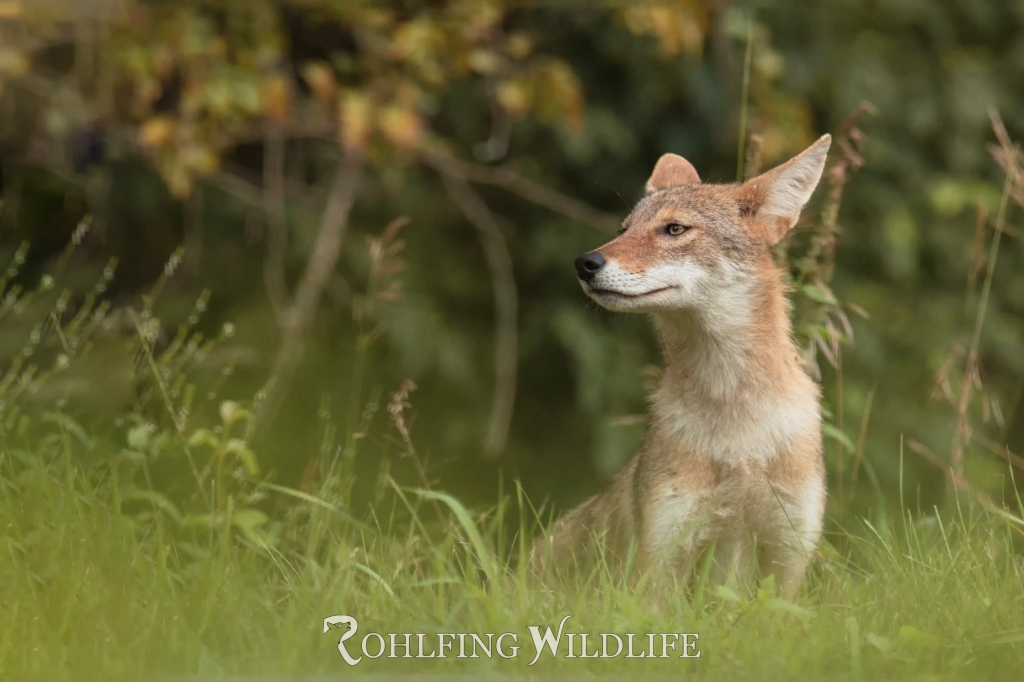
Now that we’ve entered the month of March, I’m looking forward to seeing some of my new young neighbors. I live in what’s called a “wildland-urban interface (WUI) zone in Western Washington. When we lived one city over “down the road” in an apartment we would occasionally see news stories about black bears and the odd cougar witnessed in the area of where we live now. A selling point for us, not so much for more timid people though! In 2007, we finally achieved our dream of owning a home here. We live about 200ft from a primary east-west throughfare that connects a chain of small cities to a major freeway.
After a few months I began to observe a parallel throughfare right through our property in what I affectionately call “the wildlife highway.” These last few years of development have been particularly difficult in fracturing this once invisible highway. The more people move in, the more reports of sightings increase. Most realtors seem a bit coy when telling new homeowners what kind of animals they’ll be living with. This often leads to panicked Facebook posts in the neighborhood group or calls to the police, who will politely tell the people to leave the animal alone and call them back if it threatens someone. This is of little consolation to any proud urbanite that had, until now, believed that all large predators live way up high in the mountains.
I’ve become a local soothsayer of sorts in my understanding of our wild and non-wild neighbors. The human neighbors call me “Snow White” and call, text or email me when they have questions or concerns about local wildlife or want native plant recommendations. People slow down to take pictures of me gardening alongside deer, rabbits, birds, and the occasional coyote basking in the sun a few feet away as if it were my dog.

I’m now the adjunct guardian of this waystation on the wildlife highway. A sanctuary where they can rest without fear or harassment. The coyotes come for field snacks (mice) and stay for the curiosity of a woman so deeply imbedded in nature. They’ve been vilified for generations by us two-legged creatures. In our media they’re often cast as either evil creatures or dumb, pathetic things. They get no fair representation. They’re guilty of all crimes, most notably for eating all the cats. That non-native domestic species European Colonists brought with them that now decimate BILLIONS of native birds and mammals annually.1 Don’t get me wrong. I love cats as much as any other animal, but we have a responsibility to care for any animal that we’ve historically bred as pets. I empathize with any pet owner who loses a furry family member to an attack of any sort!

In Coyote America: A Natural & Supernatural History by Dan Flores2we learn how the war with the coyotes and wolves began as part of the western expansion of colonialism. As the white settlers cleared out the majority of wolves along the east coast and moved westward coyotes were able to infill where their larger cousins had once dominated. In the coyotes’ native range, he is the Creator and trickster to many plains dwelling indigenous tribes, but by the time he reaches the far western coast, home to the Coastal Salish tribes, he takes a place of no particular esteem behind their animistic creators and relatives.3
Coyotes are a lot like us in their ability to adapt. What Dan Flores refers to as “Fission-Fusion”: the ability to be both social and/or solitary. My first neighbor coyote familiarity began with a female that hunted during daylight hours in an effort to provide for her pups. She and I became known to each other. I never threatened her, and she never threatened me or my dog. We watched each other with both interest and a careful eye. One day, one of her pups strayed too far from the den and came into the yard through the driveway, only to find himself trapped in a section of the old horse pasture that, for whatever reason, had some hog wire fencing attached to it.
It wasn’t until I stepped out onto the porch for a better look that I realized it was a coyote pup and not a lost dog pup. I sat down to watch knowing that my approach would only cause undue stress. It appeared healthy and wasn’t in any immediate danger. I think that is the moment I embraced my role as the neighborhood guardian and liaison between wild and human neighbors. My policy is no intervention unless absolutely necessary.
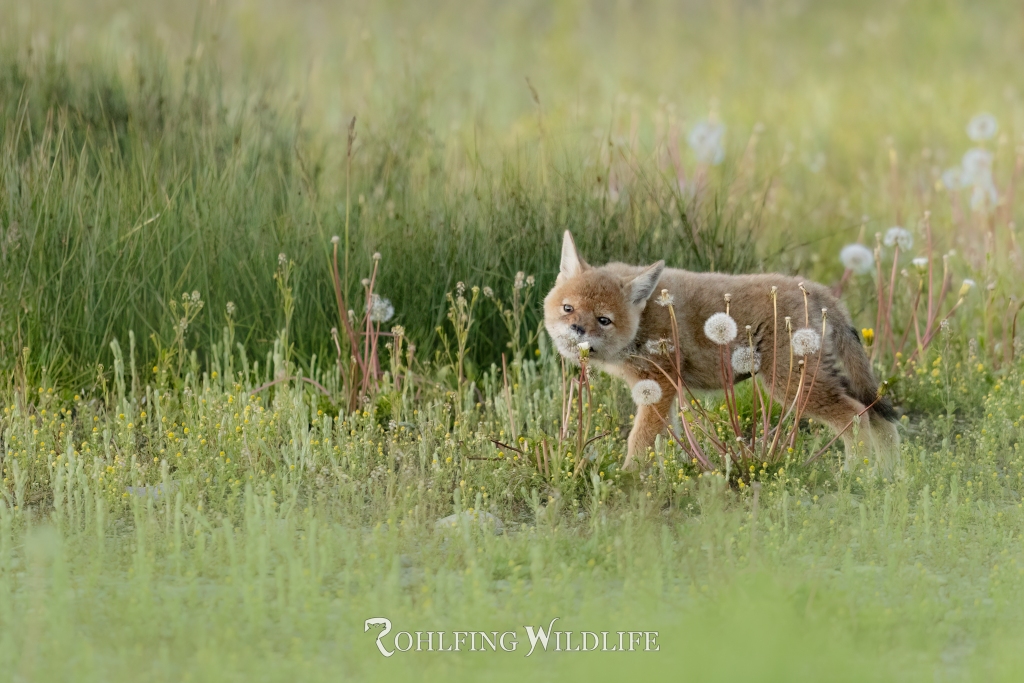
He eventually calmed himself, worked his way back to roughly where he’d come and returned to the den across the street in the wetland. The next weekend I ripped out all of the fencing. Mother coyote got skinnier and skinnier until I didn’t see her anymore. One of her sons took up the territory. I can’t say if it was the one I’d seen as a pup or his sibling.
This male coyote is the one I had known the longest. My scent was on the landscape when he was born. As generations of animals have been born around me, they too imprint a connection of my scent with the landscape they call home. I look upon them as friends of the family. I started to worry that he would try to get too comfortable around other humans and that they would fear him. I also worried that if the Washington State Fish & Wildlife department received too many calls about a coyote, they might shoot it for their own convenience to stop receiving calls about it. As I dwelled in these thoughts there was a morning where it was very windy, and I was walking my dog when we and the coyote startled each other by our sudden abrupt closeness alongside a hedge. It was in that moment I decided a bit of light hazing might be good. I clapped my hands and told it to “Go on git!”
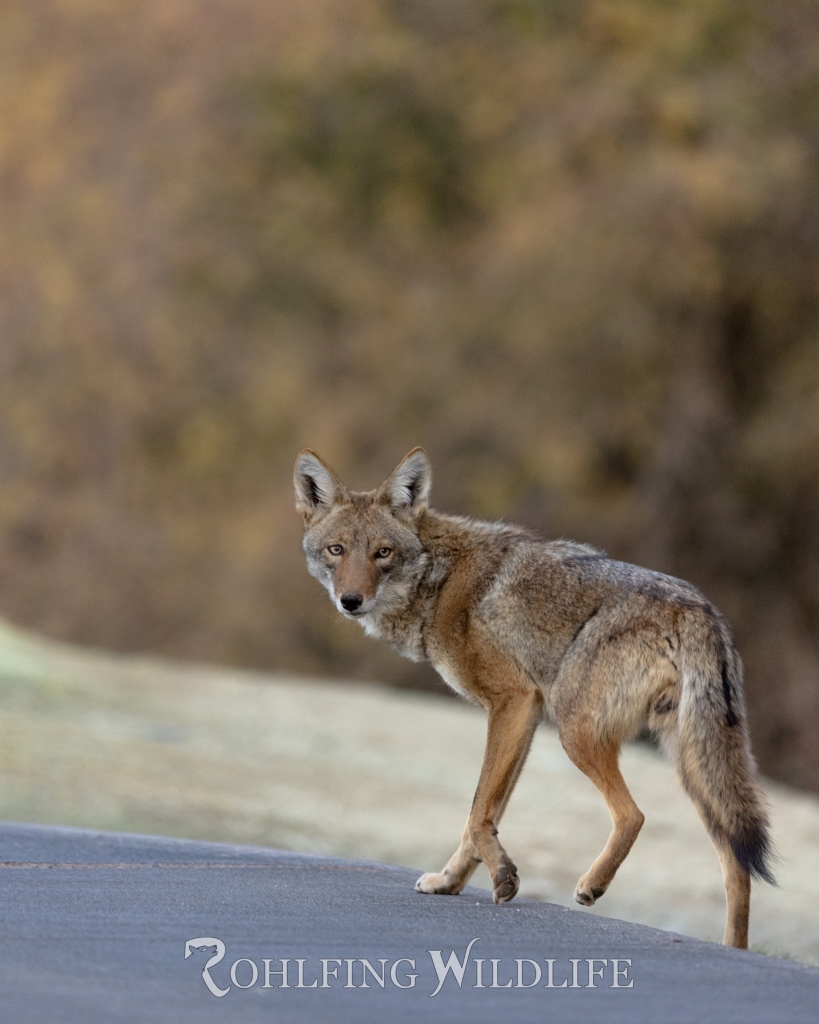
It was startled and as it trotted off it looked back at me with an expression I read as, “I thought we were friends.” I try so hard not to anthropomorphize wild animals, but his behavior afterwards conveyed what felt to me like a response to a perceived betrayal. He no longer came around me. I only knew he was still in the neighborhood when I caught a glimpse of him before he could see or smell me, but mostly he stuck to night hunting as I witnessed on my game camera. I reflect upon that moment when our friendship fractured with regret.
Sadly, this coyote got mange, which was first introduced to the North American landscape in 1905 as part of the eradication and removal plan by the US Biological Survey (now the US Fish & Wildlife Service) for coyotes and the remaining wolves. Several neighbors, who had once been apprehensive of living with coyotes, now looked upon his sorry state with sadness. I received texts late at night as they watched his suffering through their Ring doorbell cameras. I did research online and found that there was a kind of fringe movement where one could purchase anti-mange medication to put in food. The caveat was that you had to be certain the right animal would eat it. The recommendation was to trap, feed, and release. Something I couldn’t do without the risk of getting raccoons, a dog, or a bobcat by accident. The coyotes are not the most prolific hunters here but a bobcat that rarely passes me by without a large meal hanging from its mouth.
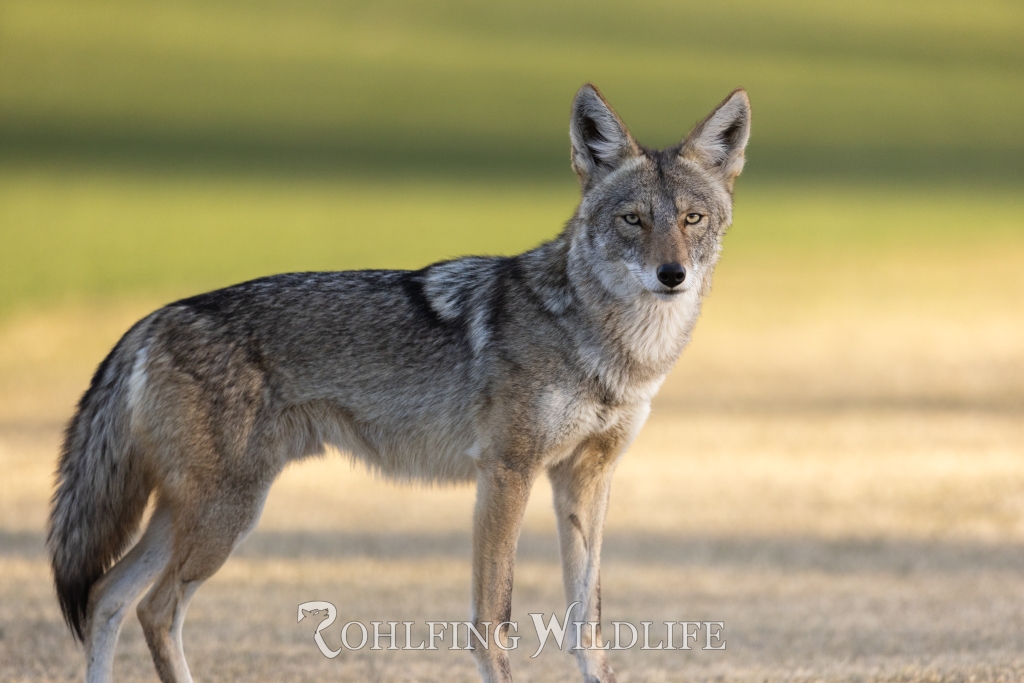
Our new young coyote neighbor was quite brazen when he was younger. Standing so close to the road with no interest in moving for cars that the neighbors, no longer with a sense of fear, would clap or yell at him to move along. “Get out of the road you idiot!” He has since learned that we prefer more personal space, about 25ft or so. This is his first year of having a family of his own. He met his mate this last November for mating season.
I find it was quite amusing that he hasn’t lost his interest in experimentation. One night after three of them had greeted each other in the field like a group of crazy middle school kids they decided to pretend being dogs by barking. They practiced for over an hour until they could match each other in similar tone and range. It reminded me of how crow families develop their own personal language cues.

A few days later during a morning walk I heard a dog bark and then another dog bark in a game of call and response. I know all the dog barks in the neighborhood. I can visual the dog, the owner, and the house, just by a bark alone. Even when I don’t know a barking dog personally, I can usually make a pretty good assumption about its breed and size. It’s the coyotes I thought. One was close by, so I stopped and waited because I was between them. Sure enough, creative coyote pops out onto the road, in a fast trot but immediately slowed to a casual walk when he saw it was me and my dog. As if to say “Oh, it’s just you.” The thought of it still makes me smile.
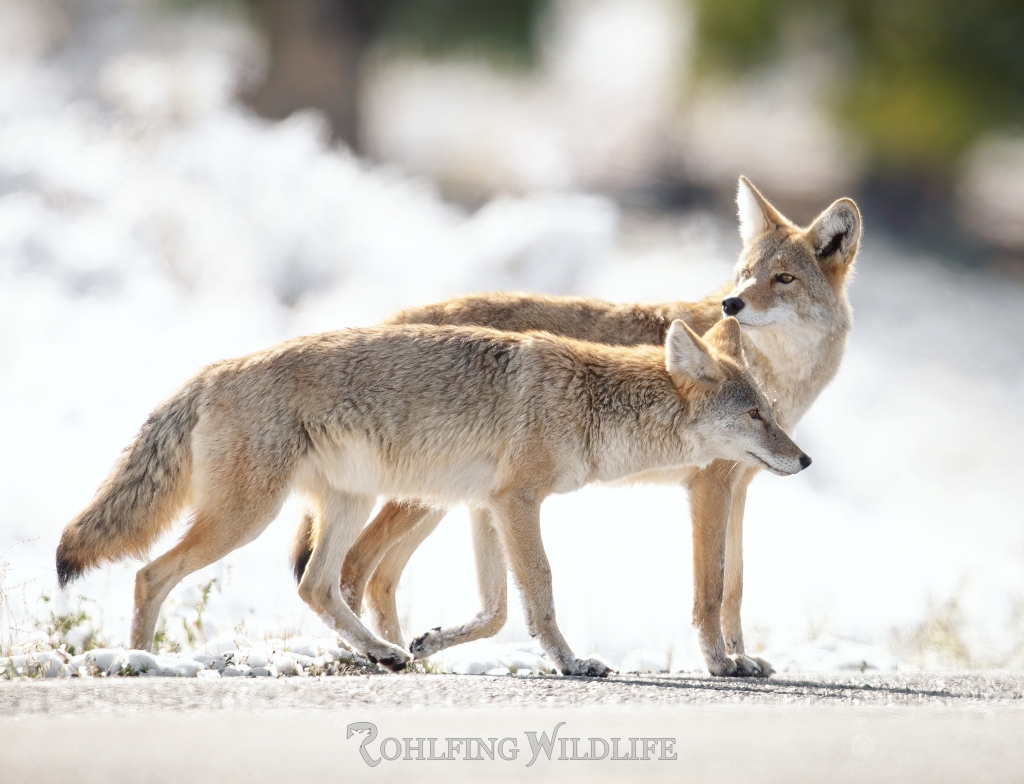
I hope you can understand that coyotes, like any other animal, are individuals with family dynamics that encourage what kind of personality they develop. There are some coyotes that can be aggressive, just as any other creature has the ability to be. I’ve never been threatened by a wild animal, of which I’ve met many, including black bears and moose. I’ve had two separate attempted attacks (both at night) one by a man and one by two dogs that tried to attack me and my dog. In both instances I walloped them with a swift kick up the side of their head. I’m fearless in many ways, but not careless. I know what I’m capable of and it’s a lot. I think the coyote and I have this in common. What do we fear? The gaze of a very hungry mountain lion.

~ A Special Thank You ~
This post was made possible with the generous contribution of Kyle Rohlfing Photography for allowing me permission to share his fine photography with you. You can see more of his wildlife photography at:
Socials:
Instagram: https://www.instagram.com/rohlfingwildlife
Facebook: https://www.facebook.com/RohlfingWildlife
These images are copyrighted. All rights belong to Kyle Rohlfing.
———————————————————————————————————————————
References:
- The impact of free-ranging domestic cats on wildlife of the United States | Nature Communications , 2013
- Coyote America: A Natural and Supernatural History by Dan Flores | Goodreads. Mr. Flores is also an ambassador for the nonprofit group, Project Coyote – End Wildlife Killing Contests – Project Coyote
- A Lushootseed story about coyote: Cannibal Woman Chases Coyote, Told by Charley Anderson , 1954 kstrom.net/isk/stories/baskcoyo.html

Kyle’s photos are stunning! I went over to his website and he has so many wonderful prints over there. I may need to get a something for my office.
LikeLiked by 2 people
Yes, they are! I’ve bought two; the otter and the fox kit with the feather. Thanks for stopping by, Mark! I hope you are well!
LikeLiked by 2 people
We occasionally have coyotes here in the city, although I’ve never seen one. Most people are delighted by the visits, because they are so rare. If you live in an area with wild animals, I believe, with you, that you need to learn to share the space. Unfortunately we’ve taken up so much land that wild animals are causing problems in many dense suburban areas around here–they have no place to go. Children playing outside being attacked by the occasional bear among other things. Bears breaking into houses. Of course raccoons break into houses too, and they are fierce as well. We no longer know how to live with the natural world. I know I don’t, at all. Our grandparents knew. All that lost in two generations. (K)
LikeLiked by 2 people
Attacks by wild animals are really, really rare. It’s only because they are rare that they’re more likely to make the news and then people get a distorted perception of how dangerous an animal is. You’re much more likely to get attacked by a person or domestic dog. People should have to sign a liability waiver and an agreement not to be an idiot when they visit national parks. Rarely does a wild animal want to take a selfie with stinky humans. I’ve always been a bit feral, myself. When people used to ask if I was afraid to be a young girl in the woods by myself, I would always say, “Heck no, humans are the most dangerous animals! I’ve to navigate much more dangerous situations in the city than in the forest. Creeps on the bus, ones that follow you on the street, or through stores, no thank you!
LikeLiked by 2 people
I have to object to the negative view of cities everyone seems to buy into–just like the negative view of immigrants and other stereotypes.. The per capita crime rate here is actually quite low–there are no more creeps here than anywhere else, there are just more people. I do agree humans are dangerous in general though. And that much of their behavior in wild places is clueless. OK their behavior in general is clueless. That’s why they often get into trouble in cities too.
LikeLiked by 1 person
I agree. I didn’t mean for my last sentence to sound like a generalized sideswipe of living in cities. I was speaking of personal experiences I’ve had with men who for whatever reason thought it was acceptable to follow a young woman around like it was some kind of sport. This was in a medium-sized blue-collar city that would be politely referred to as “rough around the edges.” When I moved to Seattle it was safer in unexpected ways. Easier not to stand out and get lost in the crowd when you want too. I’ve always made at least one or two neighbor friends in every apartment building I’ve ever lived in.
LikeLiked by 2 people
For some reason, the world thinks its acceptable to take swipes at cities–especially NYC. Men everywhere are disrespectful to women, starting from middle school on. It’s cultural.
LikeLiked by 1 person
Amazing photos. No coyotes here! 😊
LikeLiked by 1 person
I guess they were too busy trying to eradicate them to think of sending any back to Europe. I read not long ago that Germany has a raccoon problem because Nazi Germany thought it would be a good idea to bring some over to boost the fur trade. Jokes on them, plenty of Raccoons escaped. There’s no limit on the number of short-sighted men in positions of power throughout human history.
LikeLiked by 2 people
I loved this>
” I’m fearless in many ways, but not careless. I know what I’m capable of and it’s a lot. I think the coyote and I have this in common.”
A lot of people here *San Diego, CA* have encountered rattle snakes…I am not sure what I am capable of or what I have in common with the vipers…but stomping for sure will daunt me.
LikeLiked by 1 person
Rattlesnakes are so cleverly designed to look like their surrounding environment! If you haven’t trained your eyes to look out for them, you might want to walk with a stick in front of you like a blind’s man cane in rocky areas. We have rattlesnakes in Eastern Washington. There’s this one rest near Schrag heading eastward that I always keep the dog real close and never venture far from the pavement. Prime rattlesnake territory.
LikeLiked by 1 person